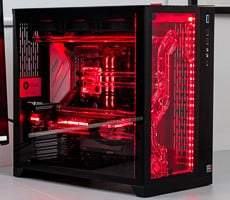Alienware 17 R4 2017 Gaming Laptop Review: Powerful And Refined
|
The ATTO disk benchmark provides a glimpse of how fast the SSD performs in the Alienware 17. The single SSD is a high-end Toshiba XG4 unit that sports a NVME PCI Express interface, which is what we expect in a high-performance desktop replacement.

The NVME SSD doesn’t disappoint and takes advantage of the additional PCI Express bandwidth (versus SATA) for peak read performance of 1.8 GB/s. Write performance is slower at a peak of 1 GB/s, but still substantially faster than a traditional SATA SSD. The fast read performance cuts down on load times, which means less time waiting for games to load and more time spent playing.
|
Next up is the Sunspider Javascript benchmark, which provides a balanced real-world test. We used the default Edge browser in Windows 10 to run the benchmark.

The results aren’t surprising with the Alienware 17 topping the chart. The Alienware 17 is the first quad-core Kaby Lake notebook we’ve come across, that also happens to be packing bleeding edge storage, a fast GPU, and plenty of high-speed memory, and it edges out the previous generation Skylake-based models as a result.
|
Cinebench tests the systems CPU and GPU independently and provides a good indication of raw performance. The test is based on Maxon’s Cinema 4D modeling software that’s used in movie productions like Iron Man 3.

The Alienware 17 dominates here. The latest Kaby Lake CPU gains a 29-percent edge in CPU performance over Skylake. The GeForce GTX 1080 performs commendably in the Alienware 17, but it’s not a fair fight when put up against the GTX 970M in the CybertronPC CLX Osiris 14 and other machines -- mobile Pascal is simply in a different league.






